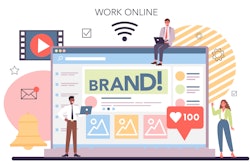
I hear this often: Many equipment rental businesses feel they cannot compete online because they don’t have the marketing budgets that the larger, national chains do.
However, there is an incredible amount of opportunity for dealers and rental companies to win on Google without spending a dime on paid advertising. So I’ve designed this guide for the same reason we built Gearflow.com — to help your business compete online as more customers go digital.
Although this guide is geared more toward suppliers in the construction equipment industry, these tactics can be applied to any business. By following this guide to rental marketing and sticking to it, you will not only outrank your competition on Google, but you will also do it without spending a dime on advertising.
Let’s get to it!
The Consumer is Changing; Don’t Get Left Behind
Before we get into the tactics, I want to emphasize why your digital presence is so important. I’ve written about the need for eCommerce in construction given the change in consumer behavior.
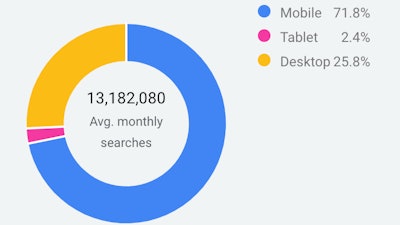 Approximate monthly searches in the U.S. for construction equipment related terms.
Approximate monthly searches in the U.S. for construction equipment related terms.
There are roughly 13 million searches a month for construction equipment related terms in the U.S., with three-quarters coming from mobile devices. This amounts to a lot of opportunity for the businesses that win on organic search. However, to win search, you must show up on the first page of organic results on Google. You should note that 75% of all clicks for any given Google search go to the top three organic spots.
The 10th spot on the first page, which is the last result on the page, has a 3% click through rate (CTR).
What happens if you fall off the first page? The second page on Google has a combined CTR of 0.78%.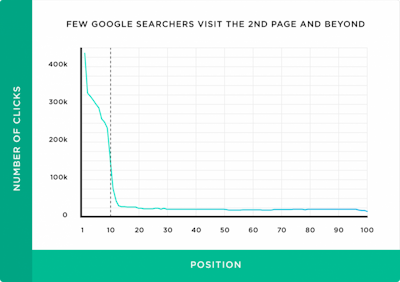 75% of all clicks go to the top three organic spots.Backlinko
75% of all clicks go to the top three organic spots.Backlinko
Let’s recap these stats:
- 71% of your buyers are starting their purchase with an online search.
- 75% of them are clicking the top three organic spots on Google.
You cannot buy those customers. The average CTR for the sponsored results purchased through Google Adwords for the business to business (B2B) category?According to Wordstream, 2.41%. That means that you have a better chance of getting a customer to your website if you are the 10th organic spot than if you paid for a sponsored result. So, how do you land on the first page of Google?
This is what is called Search Engine Optimization or SEO.
What is SEO and Why is it Important?
Google’s primary job is to surface the most relevant, trustworthy, and authoritative information for any given search while also matching the intent of the search. They do this by way of their ever-evolving algorithm, which ranks the expertise, authoritativeness, and trustworthiness of every URL on the internet based on roughly 200 different factors.
SEO is the practice of optimizing your website and content against each of these factors to give your website the best chance to be highly ranked on searches relevant to your business. SEO is often confused with search engine marketing (SEM), but the goal of SEO is to acquire organic traffic. SEM includes strategies to acquire both organic and paid traffic.
Organic traffic acquisition does not require an advertising budget, but it does require time and patience. In fact, it typically takes six to 12 months of regular content marketing for the effects to take hold.
The following is a case study from an equipment rental company that invested in SEO as their primary customer acquisition channel:
For five years since their founding, their traffic was relatively flat. In May 2017, they started investing in their blog and regularly posting articles strategically written for SEO. At this point, they had about 7,500 unique visitors to their website a month. By December 2017, they still were only seeing 9,000 unique visitors a month. However, they continued to invest their time in content.
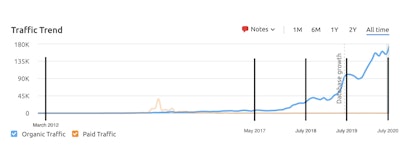 Content marketing typically takes six to 12 months to bear fruit.
Content marketing typically takes six to 12 months to bear fruit.
Content marketing has compounding effects, but it requires patience and consistency to hit an inflection point in traffic. Most businesses give up on their content marketing efforts before they hit that inflection point. What most people don't get is SEO is not as simple as posting blogs and hoping people find them. Content marketing requires a formulaic approach that extends far beyond keeping up with a blog.
Now, I’m going to walk you through a recipe for success in rental company content marketing and SEO.
Table Stakes
This chapter covers the table stakes – or the (fairly) painless wins that cost you little to nothing financially.
Modern Website
If you have an outdated website, you are not alone. The good news is that, contrary to popular belief, creating a modern website does not require an agency that specializes in rental businesses, a freelance software engineer, or a listing site to build and host your website for you. In fact, a modern website is more achievable now than it ever has been before.
The bad news is that if you don’t have a modern website, then the rest of this guide is moot.
Site builder tools such as the two I recommend, wix.com and WordPress, allow you to create beautifully designed websites with built-in lead generation functionality for less than $100 a month. Their tools are intuitive, have many helpful third-party integrations built in, and are already technically optimized for SEO.
These websites will not necessarily get you a total eCommerce solution, but they will get you halfway there — a clean-looking site that represents your brand and enables you to attract customers online.
Google My Business
Google My Business is a free tool from Google that allows local businesses to appear in local searches and on Google Maps. Google ranks local businesses based on relevance, distance, and prominence. Prominence is the one factor you can control.
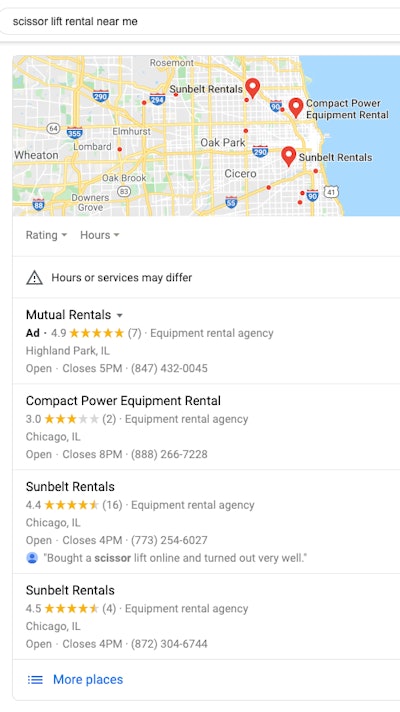 Google My Business accounts are required to have you appear in local searches like this one for "scissor lift rental near me."
Google My Business accounts are required to have you appear in local searches like this one for "scissor lift rental near me."
- Ask your customers to leave reviews on your business to help with your local search results.
- Manage and respond to your reviews. This shows that you are engaged, and Google will reward you for that engagement.
- Add photos, posts, and products to your Google My Business page. Completeness and freshness of the content on your page boost your rankings.
Google My Business is a must-have to appear in local searches, such as “Scissor Lift Rental Near Me,” as it’s free and takes less than an hour of work to get set up.
Google Search Console
Google Search Console is a free tool to help you understand how your website is being indexed by Google and what errors need to be addressed. It will also identify what search queries you are appearing in and how many clicks you are earning over time. This is important: Google Search Console is where you submit your sitemap. You can think of your sitemap as the blueprint of your website, as it makes it easy for Google to find your site’s pages and understand the contents.
Social Media
A lot of businesses in the construction equipment space do not have a social media presence. Most of them are under the assumption that their customers do not use social media.
The statistics say otherwise.
- 78% of adults 30-49 and 64% of adults 50-64 use social media.
- 76% of all Facebook users visit the site every day.
- The average person spends 50 minutes a day on Facebook and its properties.
Even if customers in the construction industry spend half the time that the average person does on social media, you still have an opportunity to get your brand in front of your customer for 25 minutes a day. The social following that a site such as MachineryTrader has achieved is proof that there is a large audience on social media in the market for construction equipment and rental.
It takes time, quality, and consistency to build a large social media audience. It does not require any money.
Newsletter
On average, email generates $38 of revenue for every $1 spent and is 40x more effective than social media. A newsletter is an excellent opportunity to build relationships, attract new customers, and promote your business.
Email newsletters should contain content that people actually want to read (a breakthrough, I know). Too many newsletters are used as promotions, especially in the heavy equipment and tool industry. This is the wrong way to think about email marketing. Instead, provide insights into your business, promote your best customers, and offer guidance. Give your readers a reason to read and share your newsletter.
Hubspot and Backlinko are both examples of companies that have done an outstanding job with their email newsletters. The free content that these companies distribute has led to hundreds of thousands of email subscribers for each of their businesses.
Again, you may think that email marketing doesn’t work for the construction industry. But again, the statistics say otherwise. The construction industry has the second highest email open rate (45%) among the 28 industries analyzed by Hubspot.
Start with free tools such as Mailchimp or Constant Contact and grow from there. Just remember to tone down the promotional content, and instead, be a resource to readers.
Now that we’ve covered the fundamentals of how to succeed in rental marketing online, including understanding your changing customer, what SEO is, and the table stakes, the second part of this guide will help you with simple next steps in content marketing for your business.
Come back to Rental to learn how to decide what content to create and how to make sure that content ranks in the top spots of organic search on Google in order to direct prospects and customers to your rental business.
*This article was adapted from its original version, “The Ultimate Guide to Construction Marketing,” on the Gearflow.com blog with permission from the author.




